Digital Interconnect Cables - What's Your Experience?
Comments
-
"steveinaz wrote: »Exactly, it's my "theory" that sending/receiving interfaces that have stricter standards (higher quality) would have far more signifigance in the digital realm than the cable connecting them.
We talk alot about the DAC, and the analog output section, but we rarely get into the weeds of the connecting interface electronics. I believe in equipment like DK's or BlueFox, these guys have moved to the "next level" where they are benefitting from truly precise digital interfaces in their equipment.
If it turns out that my digital interface quality negates the need to spend a lot of money on digital cables, that's great.
Proud and loyal citizen of the Digital Domain and Solid State Country! -
DarqueKnight wrote: »If it turns out that my digital interface quality negates the need to spend a lot of money on digital cables, that's great.
LOL. I suspect it is the other way around. With the better gear, an inferior cable will be more obvious as it degrades the sound quality.
Lumin X1 file player, Westminster Labs interconnect cable
Sony XA-5400ES SACD; Pass XP-22 pre; X600.5 amps
Magico S5 MKII Mcast Rose speakers; SPOD spikes
Shunyata Triton v3/Typhon QR on source, Denali 2000 (2) on amps
Shunyata Sigma XLR analog ICs, Sigma speaker cables
Shunyata Sigma HC (2), Sigma Analog, Sigma Digital, Z Anaconda (3) power cables
Mapleshade Samson V.3 four shelf solid maple rack, Micropoint brass footers
Three 20 amp circuits. -
LOL. I suspect it is the other way around. With the better gear, an inferior cable will be more obvious as it degrades the sound quality.
I think it depends on what the cable will be asked to do. If all it has to do is transmit clean digital pulses over a short distance, then any cable that meets transmission specs will do. If it has to filter out noise or deal with digital interfaces that do not exactly meet spec, then I can see a basis for there being a lot of audible variation in digital cables.
Proud and loyal citizen of the Digital Domain and Solid State Country! -
Yes. I keep forgetting your are now in USB land, and I am AES SPDIF.Lumin X1 file player, Westminster Labs interconnect cable
Sony XA-5400ES SACD; Pass XP-22 pre; X600.5 amps
Magico S5 MKII Mcast Rose speakers; SPOD spikes
Shunyata Triton v3/Typhon QR on source, Denali 2000 (2) on amps
Shunyata Sigma XLR analog ICs, Sigma speaker cables
Shunyata Sigma HC (2), Sigma Analog, Sigma Digital, Z Anaconda (3) power cables
Mapleshade Samson V.3 four shelf solid maple rack, Micropoint brass footers
Three 20 amp circuits. -
No, I am in coax SPDIF land. My journey to DSD/USB land has been problematic. I'm still looking for a DAC that does DSD and that has the same or better sound and build quality as my Cary CD 306 Pro Version.
With regard to digital coax and AES cables between my BDP-1 and the Cary, I haven't heard a difference between sub $10 cables and those costing hundreds.Proud and loyal citizen of the Digital Domain and Solid State Country! -
DarqueKnight wrote: »LOL. I suspect it is the other way around. With the better gear, an inferior cable will be more obvious as it degrades the sound quality.
I think it depends on what the cable will be asked to do. If all it has to do is transmit clean digital pulses over a short distance, then any cable that meets transmission specs will do. If it has to filter out noise or deal with digital interfaces that do not exactly meet spec, then I can see a basis for there being a lot of audible variation in digital cables.
Theoretically that's true, but how do you know if a cable meets those specs ? Most don't exactly post them. Same goes for digital interfaces.
The ability of one cable over another to reduce noise certainly could account for differences in sound....that's the obvious. Still even then, there is some significant differences in digital coax cables that I can only contribute noise reduction as just a part of the equation. Maybe it could be one is so out of whack spec wise, and another spot on, I dunno. Maybe speed of those digital pulses play a part ? If so, a cables design and metallurgy would also play a part in speed.
A digital coax cable connects two digital interfaces, one sending and one receiving. If either isn't up to snuff, how will you know which isn't ? Are there even standards for them ? Maybe in the computer world, but I haven't seen any in the audio world. Maybe I'm missing something too, because in the computer world, digital is digital and the transmission of 1's and 0's as data is relatively easy. I would assume the same transmission of 1's and 0's as sound though has a few more variables that can effect it.HT SYSTEM-
Sony 850c 4k
Pioneer elite vhx 21
Sony 4k BRP
SVS SB-2000
Polk Sig. 20's
Polk FX500 surrounds
Cables-
Acoustic zen Satori speaker cables
Acoustic zen Matrix 2 IC's
Wireworld eclipse 7 ic's
Audio metallurgy ga-o digital cable
Kitchen
Sonos zp90
Grant Fidelity tube dac
B&k 1420
lsi 9's -
LOL. I suspect it is the other way around. With the better gear, an inferior cable will be more obvious as it degrades the sound quality.
I think what you're saying is very true in the analog realm, but I believe the opposite to be true in the digital realm; because I believe connecting interfaces are an after-thought in most gear. Not that cables don't matter, they just don't have the overall impact that a super-high quality connection interface does.
Just my theory.
Source: Bluesound Node 2i - Preamp/DAC: Benchmark DAC2 DX - Amp: Parasound Halo A21 - Speakers: MartinLogan Motion 60XTi - Shop Rig: Yamaha A-S501 Integrated - Source: Rotel CD14MkII CD Player - Speakers: Elac Debut 2.0 B5.2 -
DarqueKnight wrote: »With regard to digital coax and AES cables between my BDP-1 and the Cary, I haven't heard a difference between sub $10 cables and those costing hundreds.
Precisely what I found in the belden 1694A. A $23/mtr dig coax, but it is very highly spec'd for 75ohm transmission. They work beautifully with my Benchmark DAC.
Source: Bluesound Node 2i - Preamp/DAC: Benchmark DAC2 DX - Amp: Parasound Halo A21 - Speakers: MartinLogan Motion 60XTi - Shop Rig: Yamaha A-S501 Integrated - Source: Rotel CD14MkII CD Player - Speakers: Elac Debut 2.0 B5.2 -
More digital cable trials...this time coax.

Clockwise from top: Revelation Audio Labs CryoSilver digital coax, DIY digital coax made from Hitachi AVCX digital audio cable, Acoustic Research Performance Series High Definition Digital Audio cable, DIY digital coax made from Hitachi AX-201.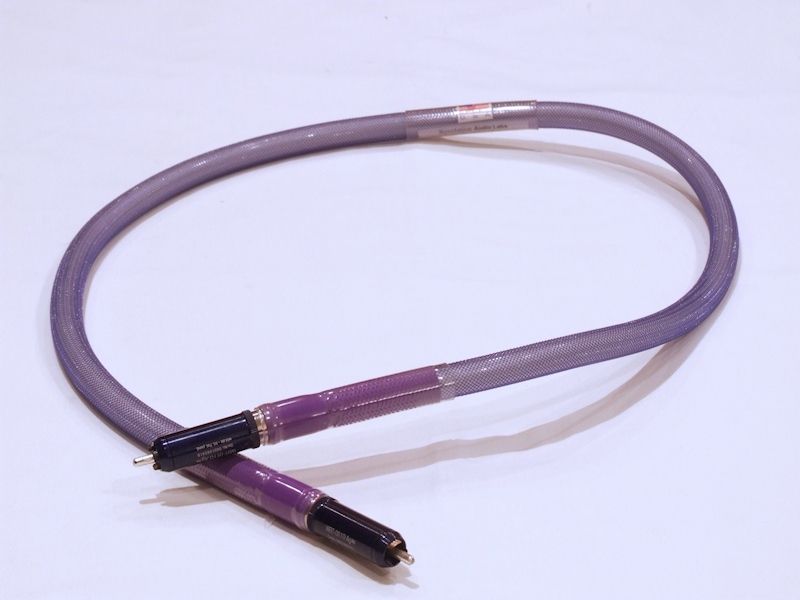
The winner-by a wide margin: RAL CryoSilver digital coax with WBT locking RCA connectors.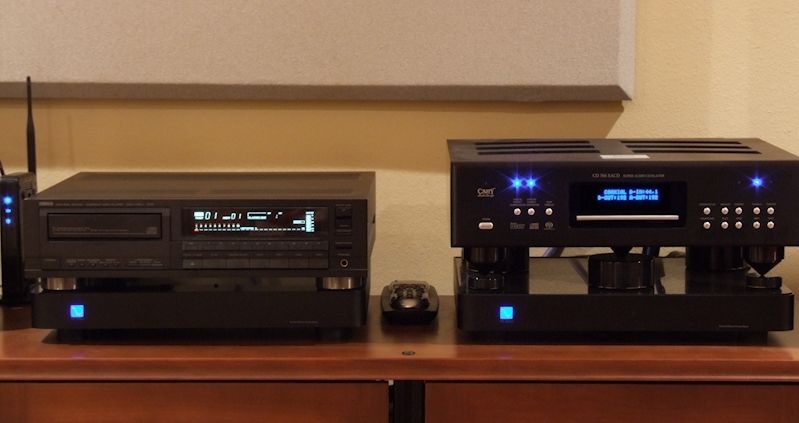
A very old Yamaha CDX-1110U CD player's transport was connected to the Cary CD 306 Pro Version's DAC.
I used a 27 year old Yamaha CDX-1110U CD player as a digital source. There was no audible or other sensory difference between the two Hitachi cables and the AR cable. There was a significant difference in clarity, detail, and tactile sensation between the RAL cable and the others. The increased tactile sensation was the biggest difference.
I purchased the RAL cable off Audiogon. I also purchased an RAL dual conduit USB cable off Audiogon, which I will be comparing against other USB cables.
This trial marks the first time I have heard, and felt, a difference in digital cables.
Proud and loyal citizen of the Digital Domain and Solid State Country! -
Excellent Ray! Thanks for the continued update(s) of your digital cable experiences. I'm looking forward to your USB comparisons. I don't have any experience using USB cables (for music purposes) myself, so I am looking forward to reading what you experience.

Taken from a recent Audioholics reply regarding "Club Polk" and Polk speakers:
"I'm yet to hear a Polk speaker that merits more than a sentence and 60 seconds discussion."
My response is: If you need 60 seconds to respond in one sentence, you probably should't be evaluating Polk speakers.....
"Green leaves reveal the heart spoken Khatru"- Jon Anderson
"Have A Little Faith! And Everything You'll Face, Will Jump From Out Right On Into Place! Yeah! Take A Little Time! And Everything You'll Find, Will Move From Gloom Right On Into Shine!"- Arthur Lee -
Like it or not, but bits are not bits when it comes to music files.

Bits are not bits, because, digital is actually analog! This will cause naysayers of the "it's all just 1s and 0s" mindset to have a stroke, but making a pure digital signal is beyond the realm of current technology. What we call a "digital" signal would more accurately be called a quasi-digital signal.
Theoretically, a digital signal consists of a waveform that instantaneously switches between a high and a low voltage value. In reality, because of energy storage and other considerations, a signal cannot instantaneously switch between two values. If you look at a "digital" signal on a scope, it ramps up from the low value, overshoots the high value by a little or a lot, then settles on the high value, then ramps down from the high value, undershoots the low value by a little or a lot, then settles on the low value. This process repeats.
Therefore, rather than having a discrete set of two voltage values (high and low), a "digital" signal is actually composed of a set of continuous voltage values (like any other analog signal) which includes the high and low voltage values and the voltage values created during the ramp up, overshoot, ramp down, and undershoot processes. The voltage values other than the high and low constitute noise. In addition to the noise which is inherent in the digital pulse train, there is also noise generated by the digital circuitry that gets transmitted along with the signal.
It's true that a quasi-digital signal has more immunity to certain types of noise and, in many, maybe most, cases, any digital cable that meets spec will be indistinguishable from another cable that meets spec. However, if the digital cable has been designed to address specific types of noise and if the equipment involved is of sufficient resolution, and if the listener has a good evaluation methodology, an audible difference may be perceived.
Proud and loyal citizen of the Digital Domain and Solid State Country! -
That's gonna sting some naysayers Ray.

Taken from a recent Audioholics reply regarding "Club Polk" and Polk speakers:
"I'm yet to hear a Polk speaker that merits more than a sentence and 60 seconds discussion."
My response is: If you need 60 seconds to respond in one sentence, you probably should't be evaluating Polk speakers.....
"Green leaves reveal the heart spoken Khatru"- Jon Anderson
"Have A Little Faith! And Everything You'll Face, Will Jump From Out Right On Into Place! Yeah! Take A Little Time! And Everything You'll Find, Will Move From Gloom Right On Into Shine!"- Arthur Lee -
That's gonna sting some naysayers Ray.
But why would an audio naysayer be stung by science? Aren't they the ones lamenting the "lack of science" in audiophile equipment evaluations?
A digital signal is supposed to be a pulse train of square waves consisting of only two voltage values. However, as I said before, true square waves don't exist in the real world. Below is an oscilloscope plot of the square wave output of my Audiodharma Cable Cooker. Notice that the tops, sides, and bottoms of the "square wave" are not perfectly flat. The deviation from theoretical flatness ( and theoretical digital) gets more severe depending on the cable the signal goes through.
Square wave output from an Audiodharma Cable Cooker.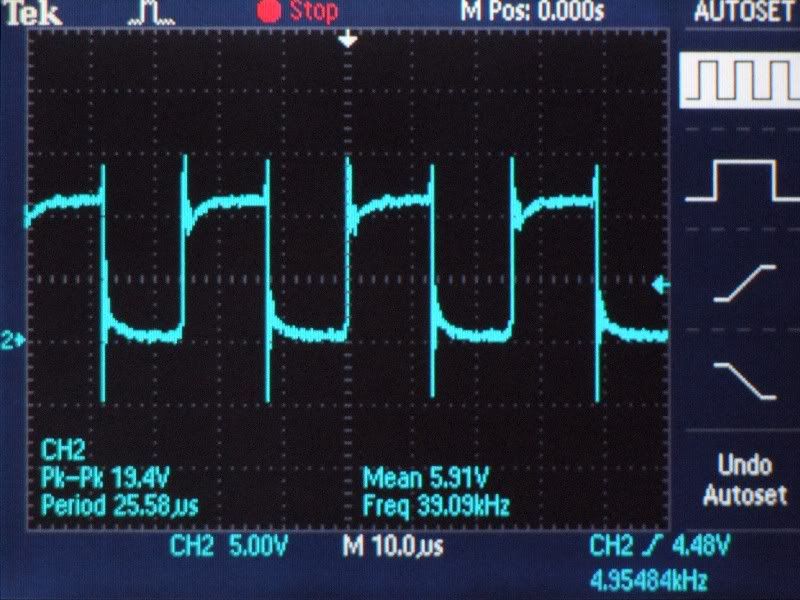
Audiodharma Cable square wave output through a DSR Silverline interconnect cable.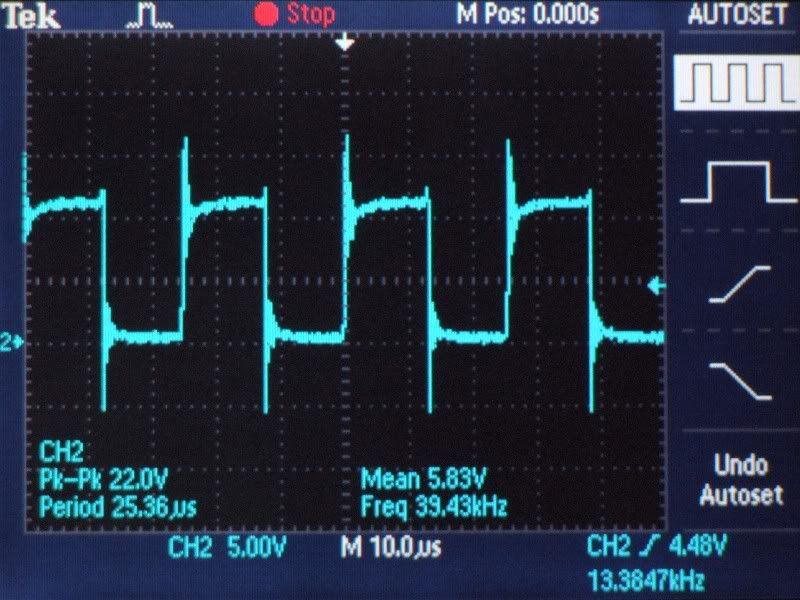
Audiodharma Cable square wave output through a PS Audio Xtream Resolution Reference interconnect cable.
Proud and loyal citizen of the Digital Domain and Solid State Country! -
Way above my pay grade. I see Batman...DarqueKnight wrote: »That's gonna sting some naysayers Ray.
But why would an audio naysayer be stung by science? Aren't they the ones lamenting the "lack of science" in audiophile equipment evaluations?
A digital signal is supposed to be a pulse train of square waves consisting of only two voltage values. However, as I said before, true square waves don't exist in the real world. Below is an oscilloscope plot of the square wave output of my Audiodharma Cable Cooker. Notice that the tops, sides, and bottoms of the "square wave" are not perfectly flat. The deviation from theoretical flatness ( and theoretical digital) gets more severe depending on the cable the signal goes through.
Square wave output from an Audiodharma Cable Cooker.
Audiodharma Cable square wave output through a DSR Silverline interconnect cable.
Audiodharma Cable square wave output through a PS Audio Xtream Resolution Reference interconnect cable.
-
But...but...but...bits are bits...


Yes, and all human beings have the same general parts, and bits are as individual as human beings. However, it is not the bit that causes performance differences. It is the noise characteristics of the bit that makes the difference.
The sad truth is that most people don't know what a bit actually looks like. They think bits are nice, neat, perfectly square waveforms. A lot happens to a bit (individual square wave pulse) as it transitions from low to high and high to low. That transition can be affected by both electrical and mechanical phenomena.
The changes seen in the 50 Hz square wave test signal were caused by adding Dynamat Xtreme vibration damping material to the interior and transport housing of my Cary Audio CD 306 Pro Version SACD player. Notice that the degree of undershoot decreases with the application of Dynamat: from 59 microseconds to 49 microseconds to 45 microseconds.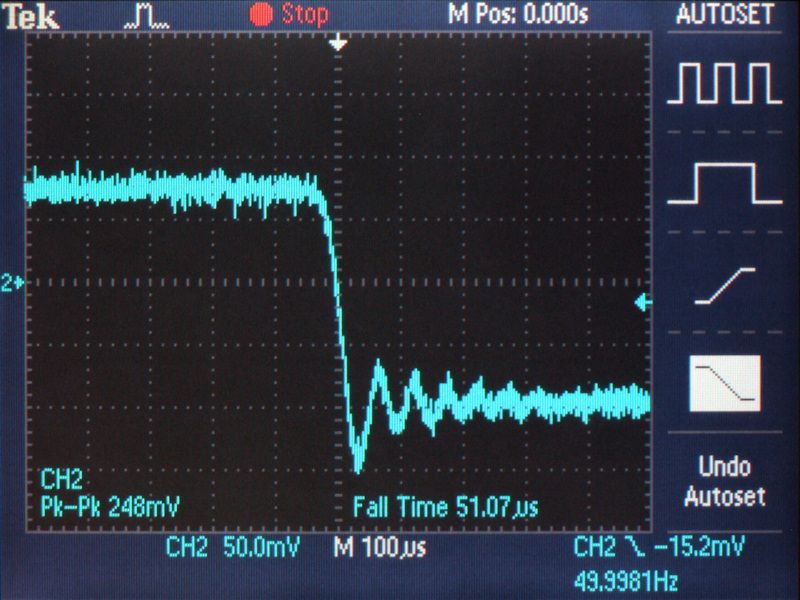
50 Hz square wave output with no Dynamat Xtreme.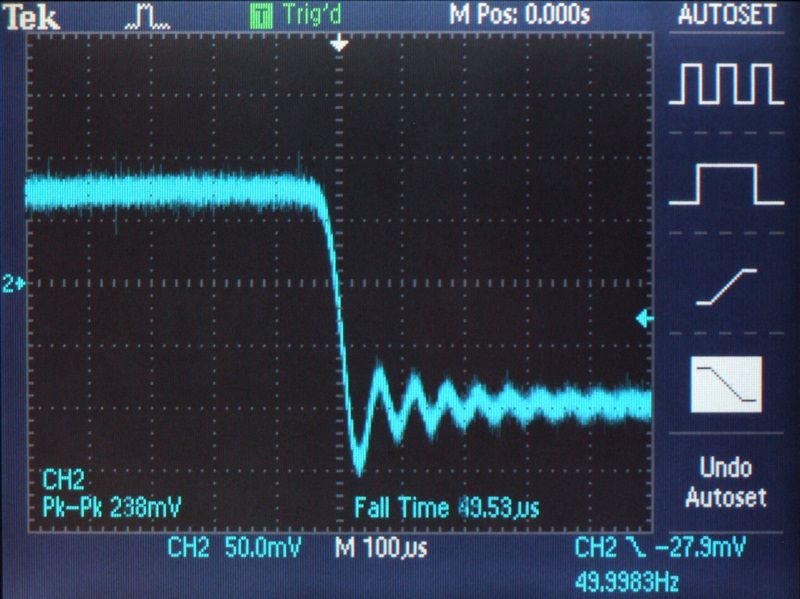
50 Hz square wave output with first application of Dynamat Xtreme.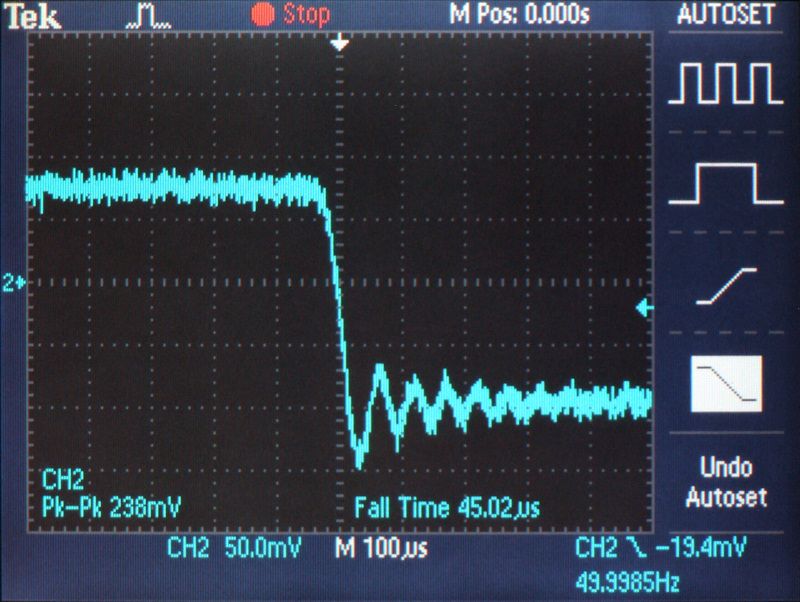
50 Hz square wave output with additional application of Dynamat Xtreme.
Proud and loyal citizen of the Digital Domain and Solid State Country! -
I try to imagine myself "riding" on the digital signal (1's and 0's, or bits) as they travel from the source, through the digital cable, and ultimately into the DAC where they are converted to an analog signal.
When you do this, you can get a sense of what it would actually be like if you were are "bit". It's similar to Einstein imagining what it would be like to travel on a "beam" of light (or traveling on a photon). This gives one a much easier to understand feeling of what a photon (or bit) would encounter as it undergoes it's journey.
Needless to say, some people are better at putting themselves in the position of a bit or photon than others. Naysayers, apparently cannot (or will not) put themselves in this position. However, your Oscilloscope measurements should help give them an idea of what it's like to "be a bit", and have them realise that (even bits ) or digital data react to forces put upon them. Yes, even digital data is a part of the universe and are subject to natural laws. I know this may seem unscientific, saying that digital signals are subject to the laws of science, but how do you get this across to someone "so scientific"?
Thanks for the oscilloscope readings Ray. Post edited by headrott on
Post edited by headrott on
Taken from a recent Audioholics reply regarding "Club Polk" and Polk speakers:
"I'm yet to hear a Polk speaker that merits more than a sentence and 60 seconds discussion."
My response is: If you need 60 seconds to respond in one sentence, you probably should't be evaluating Polk speakers.....
"Green leaves reveal the heart spoken Khatru"- Jon Anderson
"Have A Little Faith! And Everything You'll Face, Will Jump From Out Right On Into Place! Yeah! Take A Little Time! And Everything You'll Find, Will Move From Gloom Right On Into Shine!"- Arthur Lee -
Nice write up DK. The science has always been there with cables, question has always been though if it's audible or not. That question relies of course on your hearing, Trained ability to listen, and the level of gear you have to discern those differences.
You obviously have all the requirements, the only thing you needed to do was move up the ladder on the cable choice. Haven't heard the Ral yet, but I have found differences in even lessor cables.
Then comes the last question, are those differences worth the price of admission ? I would say yes, others may disagree. I look at it like this, for a couple hundred bucks in the difference between cables, you usually won't get that SQ jump for a couple hundies in gear. Tubes aside that is....and providing you have the quality gear to compliment. Glad your diggin' it.HT SYSTEM-
Sony 850c 4k
Pioneer elite vhx 21
Sony 4k BRP
SVS SB-2000
Polk Sig. 20's
Polk FX500 surrounds
Cables-
Acoustic zen Satori speaker cables
Acoustic zen Matrix 2 IC's
Wireworld eclipse 7 ic's
Audio metallurgy ga-o digital cable
Kitchen
Sonos zp90
Grant Fidelity tube dac
B&k 1420
lsi 9's -
That's gonna sting some naysayers Ray.
The biggest sting of all is the fact that "square" waves begin life as sine waves and are harmonically distorted into a quasi-square shape. It's somewhat analogous to a man having sexual reassignment surgery. He might be transformed into a convincing illusion of a real woman, but he will never have all the functions of a real woman and he will always be a man, no matter how he looks and acts.I try to imagine myself "riding" on the digital signal (1's and 0's, or bits) as they travel from the source, through the digital cable, and ultimately into the DAC where they are converted to an analog signal.
That ride would be more like a rollercoaster than bouncing up and down on a trampoline. The trampoline is what a lot of people think goes on. However, when we actually trace the outline of a square wave pulse, its a bumpy ride.
First, there is a steep ramp up, then a bumpy ride at the top: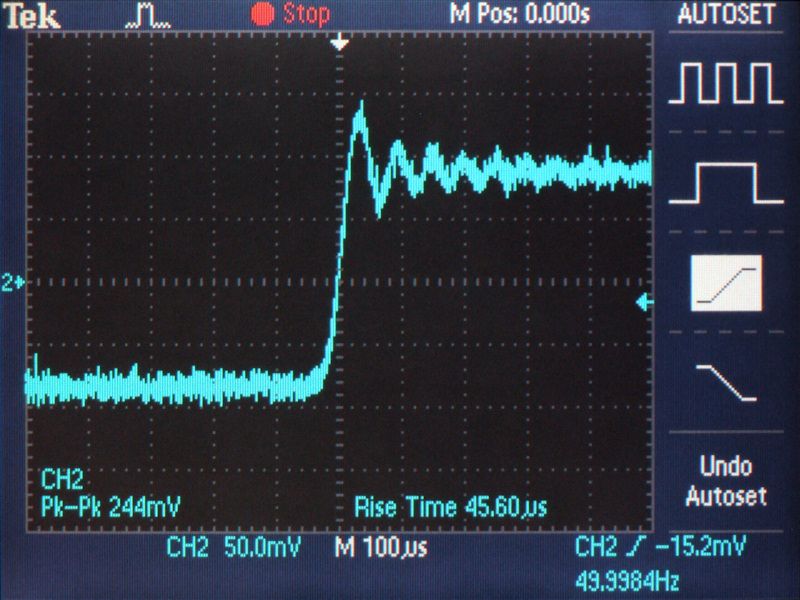
Rising edge of a 50 Hz square wave.
Next, there is a steep ramp down, followed by a equally bumpy ride at the bottom:
Falling edge of a 50 Hz square wave.The science has always been there with cables, question has always been though if it's audible or not.
That's easy enough to answer. the voltage amplitude differences are measurable. It is a simple matter to see if the measured differences fall within the range of human perception (hearing as well as tactile sensation). As you noted, even if a measured difference falls well with the range of human perception, that does not mean that a particular listener will perceive it.
Proud and loyal citizen of the Digital Domain and Solid State Country! -
Ray
Have you experimented with changing direction of digital cables to see if any differences are seen on the O'scope? Stereophile did an article a long time ago on the subject with some pretty "eyebrow raising" results. Thing was; it seemed cheap cables show the most difference/sensitivity to changing the direction of the cable.Source: Bluesound Node 2i - Preamp/DAC: Benchmark DAC2 DX - Amp: Parasound Halo A21 - Speakers: MartinLogan Motion 60XTi - Shop Rig: Yamaha A-S501 Integrated - Source: Rotel CD14MkII CD Player - Speakers: Elac Debut 2.0 B5.2 -
No, but the RAL cable is directional so I wouldn't have thought to reverse it. Now that you mention it, I think it would be an interesting experiment.
Thanks for the tip on the Stereophile article. I will try to find it.Proud and loyal citizen of the Digital Domain and Solid State Country! -
Seems to me that USB just moves files from one place to another. Doesn't seem to be a medium that can be affected by anything physical. I could see a possible speed increase/decrease, but since it's not really moving electrons across a medium, can't see how it would make a difference. Could be wrong, usually am.
-
Seems to me that USB just moves files from one place to another. Doesn't seem to be a medium that can be affected by anything physical.
What is a "file" made out of as it moves from one place to another?
Proud and loyal citizen of the Digital Domain and Solid State Country! -
Well, obviously something (electrons). But they haven't been run through a DAC yet.
-
My Bryston BDP-2 digital file player outputs digital signals to the DAC section of my Cary CD 306 Pro Version SACD player.
Inside the Cary player, when it is being used as a CD or SACD player, the disc transport feeds a stream of digital data to the DAC section.Proud and loyal citizen of the Digital Domain and Solid State Country! -
Right, but the sub just transports the file. If the integrity of the 48/192, or whatever, remains intact, what difference does it make when it reaches the decoding DAC?
I'm spiralling here. Thinking of say going from an external hard drive to a DAC. -
That was supposed to say spitballing
-
The file can maintain integrity, can still be properly decoded, yet bring with it accumulated noise artifacts that can have an audible effect. That is why the same digital file sounds different when fed to my DAC by either my BDP-1, BDP-2, or XPS-M1330 laptop computer.
I have never fed a DAC directly from an external hard drive.Proud and loyal citizen of the Digital Domain and Solid State Country! -
Gotcha. Not overly experienced with different usb cables, but i have heard differences in digital coax cables.
With the usb, just trying to approach the question with first principles. -
Don't think so. The coax is transporting a converted signal, whereas usb transfers files. Never seen a dig coax out of a hard drive. My point is that we are talking about file transfer, not a DAC converted signal.
-
A "DAC converted signal" is an analog signal. The sign is digital until it is handed off to the DAC.
The files are in binary format when they are stored on a hard drive and the signals representing the files as they transfer will be in binary (digital) format. The signal flow in my two channels system is as follows:
Binary music file stored on BDP-2 digital file player's hard drive ==>file is transported as a digital signal through the BDP-2 and is exits via the USB, coaxial, or AES/EBU output ==>digital file (as a digital signal) is transmitted through digital cable to the CD 306 Pro Version's digital to analog converter stage==> digital signal is converted to an analog signal and is transmitted to the XP-30 preamp's input.Proud and loyal citizen of the Digital Domain and Solid State Country!






